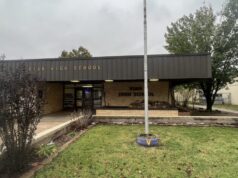
DES MOINES, Iowa — At 7:30 p.m. on Thursday night, only a few yards of snow separated several protest groups from hundreds of supporters at President Donald Trump’s rally.
For many, Trump’s event at Drake University was more of a viewing party. The indoor venue had reached capacity hours before its 7 p.m. start time, and attendees instead gathered outside. A large screen showed the president’s speech, and people huddled together to cheer in the 30-degree weather.
This story was reported by Gaylord News, a Washington reporting project of the Gaylord College of Journalism and Mass Communication at the University of Oklahoma.
Chants — “love trumps hate,” “Donald Trump has got to go,” “black lives matter” — forced their way over the claps, praises and the president’s voice itself. One group protesting was the League of United Latin American Citizens.
“For us, this is a matter of life and death,” said Joe Enriquez Henry, president of the organization’s Council 307 in Des Moines. “We’ve had to deal with his hate mongering for four years now.”
Enriquez Henry referenced both the El Paso shooting and a Dec. 9 incident in which a Des Moines woman ran over a 14-year-old girl with her vehicle because she believed the girl was “a Mexican.”
“[It’s] evidence of the Trump rhetoric that has spilled over and has led to these types of things,” Henry said.
Over a snowbank, another group of protesters stood a few feet away from Trump’s supporters. On both sides, most kept to themselves, but a small band of enthusiasts faced the wall of protesters, shaking their Trump 2020 signs. As the two groups edged closer, police separated them.
“Everyone has their own opinions on everything, not just Trump but life in general,” said Randy Vaughan, a Trump supporter and truck driver from Grimes, Iowa.
In the 2016 presidential election, Iowa had the most counties of any state, 31, pivot from Democrat to Republican. Vaughan predicts another Trump victory in 2020, saying Iowa’s conservative population is strong, even if residents don’t always voice their votes.
“A lot of people don’t come out,” he said. “They don’t show their support because sometimes people are scared to.”
In the hours before the substantial protest turnout, the Iowa opposition had looked sparse — it comprised pairs and small groups.
One pair was Lily Tennekoon, an Oklahoman from Tulsa, and Sam Spadino, who lives in Milwaukee. They rushed through the T-shirt vendor-lined streets holding Bernie signs above their heads.
Tennekoon, 18, is a freshman at the University of California, Berkeley and is missing a week of school to canvas and protest in Iowa. She’ll head to the New York Democratic primary in April to do the same.
“If we can change one mind, that’s one vote, and one vote matters,” she said.
Some, like Mary Swalla Holmes, stood with a group of friends, saw the deluge of Trump fans and noticed the initial lack of resistance.
“I think [Democrats are] working so hard for their own candidates that we almost missed the fact that Trump was going to be in our backyard,” said Swalla Holmes, who does work for Democratic presidential candidate Amy Klobuchar.
As she toted a sign calling for the president’s removal, Swalla Holmes said both her conscience and her gut told her to make the 30-mile drive to the rally.
“All Iowans are not for Trump,” she said.






















